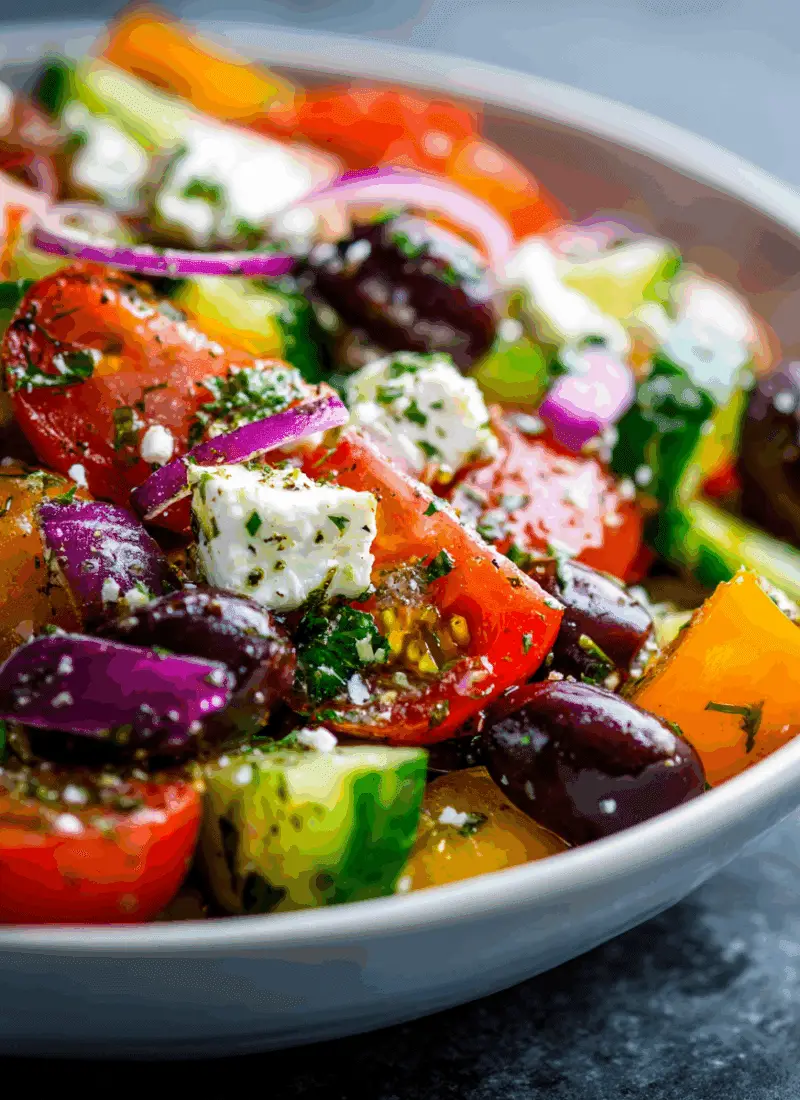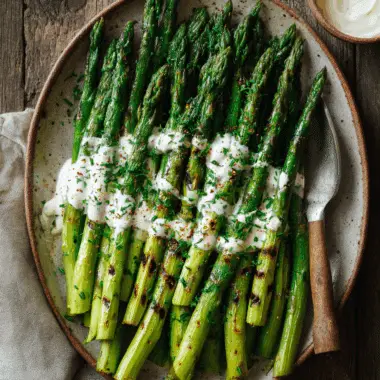The Labor Day Ultimate Greek Salad is a refreshing and colorful dish that bursts with Mediterranean flavors, making it perfect for warm-weather gatherings. Packed with juicy tomatoes, crisp cucumbers, briny olives, creamy feta, and zesty dressing, this salad is both healthy and satisfying.
FULL RECIPE
Ingredients
- 4 cups cherry tomatoes, halved
- 1 large cucumber, diced
- 1 red onion, thinly sliced
- 1 green bell pepper, sliced into thin strips
- 1 cup Kalamata olives, pitted
- 1 cup feta cheese, cubed or crumbled
- 3 tablespoons extra-virgin olive oil
- 2 tablespoons red wine vinegar
- 1 teaspoon dried oregano
- 1 clove garlic, minced
- 1 teaspoon lemon juice
- Salt and black pepper, to taste
- Fresh parsley, chopped (for garnish)
Directions
- In a large mixing bowl, combine the cherry tomatoes, cucumber, red onion, bell pepper, and olives.
- Add the feta cheese to the bowl, keeping some chunks large for extra texture.
- In a small bowl or jar, whisk together olive oil, red wine vinegar, oregano, garlic, lemon juice, salt, and pepper until well combined.
- Pour the dressing over the salad ingredients and toss gently to coat everything evenly.
- Taste and adjust seasoning if needed.
- Garnish with fresh parsley before serving.
- Serve immediately or refrigerate for up to 2 hours before serving for enhanced flavor.
Nutrition Facts
- Calories: 180
- Protein: 5g
- Carbohydrates: 9g
- Dietary Fiber: 2g
- Total Fat: 15g
- Saturated Fat: 5g
- Cholesterol: 20mg
- Sodium: 540mg
- Sugars: 5g
- Vitamin C: 45% DV
- Calcium: 15% DV
Nutritional Value and Health Benefits
The Labor Day Ultimate Greek Salad is a powerhouse of nutrients, offering a perfect blend of vitamins, minerals, and antioxidants. Fresh vegetables such as tomatoes, cucumbers, and bell peppers provide high levels of vitamin C, vitamin A, and potassium, which support immune function, vision, and heart health. Feta cheese contributes calcium and protein for strong bones and muscle repair, while olives and extra-virgin olive oil supply heart-healthy monounsaturated fats. The salad is naturally gluten-free and low in carbohydrates, making it suitable for a wide range of dietary needs, including low-carb and Mediterranean diets.
The Role of Fresh Ingredients
One of the defining qualities of this Greek salad is the emphasis on fresh, seasonal produce. Juicy cherry tomatoes, crisp cucumbers, and vibrant bell peppers not only bring color to the plate but also ensure a naturally sweet and refreshing taste. Using fresh herbs like parsley enhances aroma and flavor without adding unnecessary calories or sodium. Seasonal vegetables are also more nutrient-dense and flavorful, making them the ideal choice for this recipe. For the best results, locally sourced and organic produce is recommended.
Feta Cheese: A Flavor and Texture Star
Feta cheese plays a central role in defining the salad’s authentic Mediterranean character. Its salty, tangy flavor balances the sweetness of the vegetables, while its crumbly or cubed texture adds a satisfying mouthfeel. Traditionally made from sheep’s milk or a blend of sheep and goat’s milk, feta is rich in calcium and provides a distinct creaminess that contrasts beautifully with the crisp vegetables. For a lighter version, reduced-fat feta or plant-based alternatives can be used without compromising the essence of the dish.
Olive Oil and Vinegar Dressing Magic
The dressing is where the salad’s flavors truly come alive. A simple blend of extra-virgin olive oil, red wine vinegar, oregano, garlic, and lemon juice creates a tangy, savory coating that complements every bite. Extra-virgin olive oil is a staple of the Mediterranean diet, known for its anti-inflammatory properties and ability to support heart health. Red wine vinegar not only adds acidity but also helps enhance the flavors of the vegetables. The balance between oil and vinegar ensures the salad is light yet flavorful, never greasy or overpowering.
Customizing the Salad to Your Taste
One of the greatest advantages of the Labor Day Ultimate Greek Salad is its versatility. You can easily adjust the recipe to match your preferences or dietary restrictions. For a heartier meal, add grilled chicken, shrimp, or chickpeas for extra protein. If you prefer a vegan version, skip the feta and use marinated tofu cubes or a dairy-free cheese substitute. Those who enjoy a bit of heat can include thinly sliced chili peppers or sprinkle crushed red pepper flakes over the salad. The base ingredients are highly adaptable, allowing endless creative combinations.
Perfect Pairings for a Complete Meal
This Greek salad pairs wonderfully with a wide variety of main dishes, making it a versatile side for any gathering. It complements grilled meats like lamb, chicken, or beef, and works equally well with seafood such as salmon or shrimp. For a vegetarian-friendly pairing, serve it alongside falafel, hummus, and warm pita bread. The salad’s refreshing qualities also make it an excellent contrast to rich, savory dishes like moussaka or spanakopita, helping to balance flavors and textures on the plate.
Serving Tips for Maximum Flavor
To achieve the best flavor, it’s recommended to prepare the dressing separately and toss it with the vegetables just before serving. This prevents the vegetables from becoming soggy while allowing the flavors to fully mingle. Serving the salad slightly chilled enhances its refreshing qualities, especially on a warm Labor Day afternoon. For presentation, arrange the vegetables and cheese in colorful layers or sections before tossing, making the dish visually appealing for guests. Garnishing with fresh parsley or a sprinkle of oregano adds a professional touch.
Storage and Make-Ahead Advice
Greek salad can be stored in the refrigerator for up to two days, but for the freshest taste and texture, it’s best enjoyed the same day it’s made. If you need to prepare it ahead of time, chop the vegetables and store them in separate containers. Keep the dressing in a sealed jar and mix everything together just before serving. Avoid storing the salad with the dressing for long periods, as the salt and vinegar can cause the vegetables to release excess water, diluting the flavors.
Seasonal Variations and Ingredient Swaps
Depending on the season, you can introduce new flavors and textures into the salad. In summer, juicy heirloom tomatoes or roasted red peppers can add depth, while in winter, you might include artichoke hearts, sun-dried tomatoes, or even roasted root vegetables for a more robust flavor profile. Swapping out the herbs can also change the salad’s personality—fresh mint adds a cooling touch, while basil lends sweetness. Kalamata olives can be replaced with green olives for a milder briny flavor.
Conclusion
The Labor Day Ultimate Greek Salad is more than just a side dish it’s a celebration of freshness, flavor, and versatility. With its nutrient-rich ingredients, vibrant colors, and endless customization options, it’s a dish that can shine in both casual and formal settings. Whether you’re hosting a backyard barbecue or bringing a contribution to a potluck, this salad promises to be a refreshing highlight of the meal.








